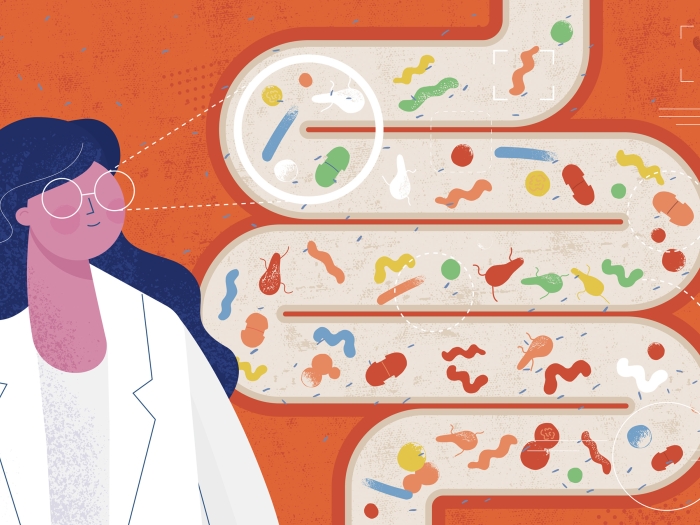Using his 3-D design training, a Michigan Medicine patient works with his doctor to improve a common tool for IBD patients.
1:00 PM
Author |

Two years ago, Michigan Medicine gastroenterologist Peter Higgins, M.D., Ph.D., M.Sc., and patient Brett Tripp were discussing 3-D printing and its capabilities during a checkup.
MORE FROM MICHIGAN: Sign up for our weekly newsletter
Tripp, who has Crohn's disease, would know: He was an architecture student at the time. And he had recently applied the 3-D printing knowledge he gained in school to create his own biomedical design company, Tripp Design.
What's more, Tripp printed his own tubes to put in his abdominal wall to relieve pressure and fluid buildup as a way to avoid a fistula — an opening in the digestive tract that can leak out to the skin or connect to an organ, causing damage or infection.
That development led the duo to brainstorm how 3-D printing technology might help another population: ostomy patients.
An ostomy is a surgically created opening in the colon brought to the surface of the abdomen used to discharge body waste.
The waste is captured in a bag, which attaches to the body by a special device called an ostomy wafer. The wafer connects the ostomy bag to the skin around the stoma, the part of the bowel protruding from the abdomen.
But the technology, as Higgins and Tripp discussed, could stand to be improved.
Patients in need
Up to 1 million people in the United States have ostomies, according to the United Ostomy Associations of America. The number varies because ostomies can be temporary or permanent.
Though the devices are helpful, drawbacks remain.
"The current technology uses a one-size-fits-all ostomy wafer," says Tripp, 33, an ostomy wearer. "That's OK if you're lying in bed post-surgery, but I'm young and active."
SEE ALSO: Traveling with IBD: 4 Key Ways to Prepare
Because Tripp has had multiple surgeries, like many patients with inflammatory bowel disease, the surface of his skin is uneven because of abdominal scar tissue. That, in turn, creates a poor seal — which tended to leak when he was weightlifting or skateboarding.
The duo collaborated to apply for a Fostering Innovation Grant, a program that funds pilot projects of Michigan Medicine faculty and staff, to pay for a scanner and 3-D printer.
Their goal: To use the scanner on patients to create a virtual 3-D model of their abdomen, and print a custom wafer directly from that scan. This would create a better wafer than what is currently available because it has the exact specifications needed for a tight seal.
Higgins, meanwhile, took to Twitter to see if he could find ostomy wearers willing to take part in a study.
The overwhelming response revealed an underserved market in search of relief.
Improving design
To date, Higgins and Tripp have created six prototypes based on 3-D models made by the digital scans of the ostomy sites and stomas on six patients, with each version improving on the previous prototype (the first versions were too stiff).
They use the scanner to create a virtual model of a mold customized to account for every divot or scar tissue bump in a patient's abdomen, print it, and make a cast of it.
Current commercial wafers are pectin-based, the ingredient that gives commercial jelly the structure of gel, but they desired a more durable material for their custom wafer.
"We settled on a medical-grade silicone that's flexible enough to maintain a seal as patients bend and move," says Higgins, who is also director of the University of Michigan IBD Program. "The problem now is optimizing the adhesive to stick silicone to skin."
Higgins and Tripp are seeking a sponsor to continue the project.
"Right now, we're at the point where our ostomy wafers are as good as what's out there now, but we want to be better," Higgins says. "We are going to get there."
Tripp agrees, particularly after taking a request from one of the study participants who moved to Colorado and wants more prototype wafers because they have made a difference in his active life.
"This impacts people's daily lives and that's motivating us," Tripp says. "We're definitely on to something."
To schedule an appointment with Michigan Medicine's Gastroenterology Division to discuss treatment for Crohn's disease, ulcerative colitis or ostomy issues, dial 888-229-7408.

Explore a variety of healthcare news & stories by visiting the Health Lab home page for more articles.

Department of Communication at Michigan Medicine
Want top health & research news weekly? Sign up for Health Lab’s newsletters today!





